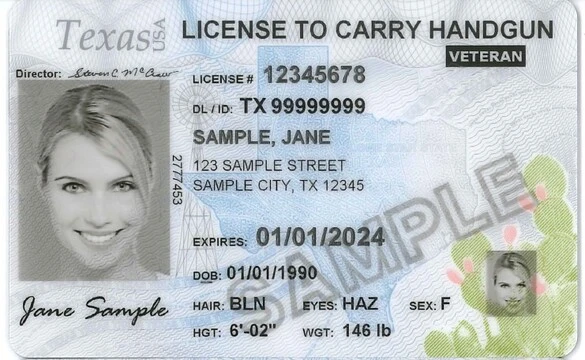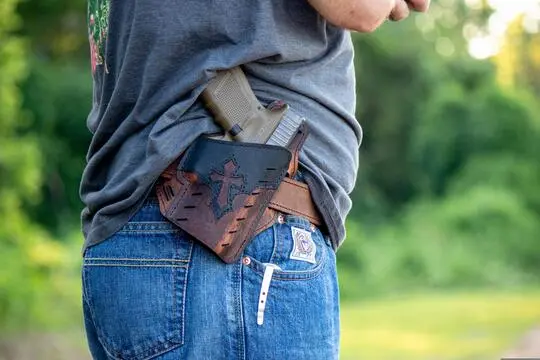Glossary
Glossaries
| Term | Definition |
|---|---|
| Automatic |
Glossaries - Carry Texas Glossary
Glossaries Description -
An automatic firearm chambers, fires, and ejects multiple cartridges with a single pull of the trigger. Also referred to as a “machine gun,” it will continuously fire rounds as long as the trigger is engaged and the magazine has ammunition. This type of gun is strictly regulated by the federal government. |
| Autoloader |
Glossaries - Carry Texas Glossary
Glossaries Description -
Any firearm that uses the gasses of the spent or fired shell or cartridge, blowback or recoil operation to eject it and load the next round. Also known as semi-automatic, such as a shotgun that can be fired without the need to manually chamber another round. |
| Assault Rifle |
Glossaries - Carry Texas Glossary
Glossaries Description -
This is a political term, and has no actual definition. |
| AR |
Glossaries - Carry Texas Glossary
Glossaries Description -
Although this term is sometimes incorrectly used as the abbreviation for “assault rifle,” it actually means “ArmaLite Rifle” and most commonly refers to the AR-15 rifle. |
| Aperture Sight |
Glossaries - Carry Texas Glossary
Glossaries Description -
Sometimes referred to as peep sights, this is an iron sight system using aligned markers to assist in the aiming of a firearm that has no mounted optics. |
| Ammunition |
Glossaries - Carry Texas Glossary
Glossaries Description -
Also referred to as “ammo” and measured in rounds, ammunition is what is loaded into a firearm. It’s made up of multiple parts, including gunpowder, primer, and a projectile wrapped in a casing. |
| Airsoft |
Glossaries - Carry Texas Glossary
Glossaries Description -
designed to shoot non-metallic spherical projectiles such as BBs made from plastic or other low-tech resins. |
| Airgun |
Glossaries - Carry Texas Glossary
Glossaries Description -
This is not a firearm, but a gun that uses compressed air or carbon dioxide (more commonly known as CO2) to propel the projectile. |
| AE |
Glossaries - Carry Texas Glossary
Glossaries Description -
Angle Eject – used by Winchester on some lever action rifles to denote that they do not eject straight up. |
| Adjustable Trigger |
Glossaries - Carry Texas Glossary
Glossaries Description -
An adjustable trigger is one that can be easily adjusted by the user to manipulate the amount of force it takes for the trigger to break and the shot to go off. Adjustable triggers are more common on specialized target-shooting firearms, but not on all firearms. |
| Adjustable Stock |
Glossaries - Carry Texas Glossary
Glossaries Description -
When a stock can extend or shorten the length from the trigger back to where the gun is braced against the shooter's shoulder. An adjustable stock is important to fit shooters of varying sizes, such as a youth hunter who will keep growing, with a compfortable firearm size. |
| adjustable sight |
Glossaries - Carry Texas Glossary
Glossaries Description -
Iron sights are a system of physical alignment markers (usually made of metallic material) used as a sighting device to assist the accurate aiming of ranged weapons (such as a firearm, airgun, crossbow or even compound bow), or less commonly as a primitive finder sight for optical telescopes. The earliest sighting device, it relies completely on the viewer's naked eye (mostly under ambient lighting), and is distinctly different to optical sights such as telescopic sights, reflector (reflex) sights, holographic sights and laser sights, which make use of optical manipulation and/or active illumination, as well as the newer optoelectronics, which use digital imaging and even incorporate augmented reality. Iron sights are typically composed of two components mounted perpendicularly above the weapon's bore axis: a rear sight nearer (or proximally) to the shooter's eye, and a front sight farther forward (or distally) near the muzzle. During aiming, the shooter aligns his/her line of sight past a gap at the rear sight's center towards the top edge of the front sight (which is usually shaped as a small post, bead, ramp, or occasionally, a ring), forming a line of aim that points straight at the desired target. Open sights are iron sights whose rear sight uses a notch of some sort, while aperture sights use some form of a circular hole. Most civilian, hunting and police long guns and nearly all handguns feature open sights, while many military battle rifles usually employ aperture sights. The earliest and simplest iron sights were fixed and could not be easily readjusted. Many modern iron sights are designed to be adjustable for sighting in firearms by adjusting the sights for elevation or windage. On many firearms it is the rear sight that is adjustable. For precision applications such as varmint hunting or sniping, the iron sights are usually replaced by a telescopic sight. Iron sights may still be fitted alongside other sighting devices (or in the case of some models of optics, incorporated integrally) for back-up usage. |
| Action |
Glossaries - Carry Texas Glossary
Glossaries Description -
The operating mechanism on a firearm that presents the cartridge for firing, removes the used casing and introduces the new cartridge. Bolt-action, lever-action, and pump-action are all examples of action types. |
| ACP |
Glossaries - Carry Texas Glossary
Glossaries Description -
|
| accurizing |
Glossaries - Carry Texas Glossary
Glossaries Description -
Accurizing is the process of improving the accuracy and precision of a gun (firearm or airgun).For firearms, accuracy is the ability to hit exactly what one is aiming at, and precision is the ability to hit the same place over and over again in a repeatable fashion. Both are the goals of accurizing, which generally concentrates on four different areas: Usability: Enhancements that give the shooter a firmer and more controlled hold on the firearm, as well as a more consistent trigger pull. Better design ergonomics is often employed, such as adjustable buttstocks and grips with more vertical angles that are natural to the human hand and wrist (e.g. pistol grip). Spirit levels are often mounted to prevent canting, which can vary the points of impact. Weapon mounts such as bipods, monopods, benchrests, shooting sticks or simply sandbags can provide a more stable and relaxed platform for the shooter, and devices such as muzzle brakes or compensators can also be used to help counter the muzzle rise from recoil and re-establish aim faster and more precisely for repeated firing. The use of suitable slings can also help shooters to stabilize their aim when shooting off-hand while standing or squatting. Tolerances: Parts that better fit together will shift less, or shift more consistently, under recoil. Rifle bedding is one of the most common practices of such accurizing procedure. Adequate screw torque setting between the action and the stock is also important for the overall rigidity of the system. Some companies, such as Savage Arms, have even introduced features like floating bolt head to provide better bolt-breech engagement for more adequate breech seal and headspacing. Harmonics: The act of firing a gun generates a rapid pressure increase within the barrel bore, causing the barrel to resonate and vibrate in a rope-like fashion. The resultant harmonic oscillations of the barrel affect the terminal phase of the projectile's internal ballistics and in turn the initial status of its external ballistics, and therefore need to be minimized or tuned to limit their effects on accuracy. Generally the harmonic effects are proportional to the square of the barrel length, and so are generally only of concern in long guns such as rifles but not handguns. Some external accessories, called tuners or de-resonators, can also be mounted onto the barrel to alter the harmonic wave pattern so that the node is shifted as near to the muzzle as possible. Airguns have significantly lower barrel pressure, and therefore are far less affected by barrel harmonics than firearms. Projectile propulsion consistency: In airguns, the inbuilt powerplants themselves provide the propulsive force to the projectile, so tuning the gun alone is usually sufficient for accurizing as long as the projectiles' weights and shapes are uniform. Firearms, however, rely purely on oxidative chemical reaction of the powder within a cartridge to provide propulsive force, and any slight variations in powder load and combustion efficiency will affect the internal ballistics of the gun, even if the projectile weights and shape are the same. This means that in addition to the gun itself, consistent ammunition performance is also extremely critical for accuracy with firearms. While some manufacturers produce match-grade ammunition with smaller tolerances, it is common for shooters of high-precision disciplines to handload and fine-tune their own ammunition. Furthermore, the rapid gas expansion that occurs when the projectile leaves the muzzle also barometrically affects flight behaviour, so muzzle devices such as flash hider and suppressor can also be used to modulate the escaping gas and improve the consistency of shots.The key to an accurate firearm is consistency. Getting everything to happen the same way for every shot is key to producing small groupings, and there are a large number of issues to be addressed in achieving an accurate firearm. The keys to firing an accurate shot are a firm but not overtight grip, the ability to get a good sight picture and a controlled squeeze of the trigger. The ability to manage recoil is also important in heavily recoiling calibers, both to aid in possible additional shots, and to prevent the user from developing a fear of the recoil. |



